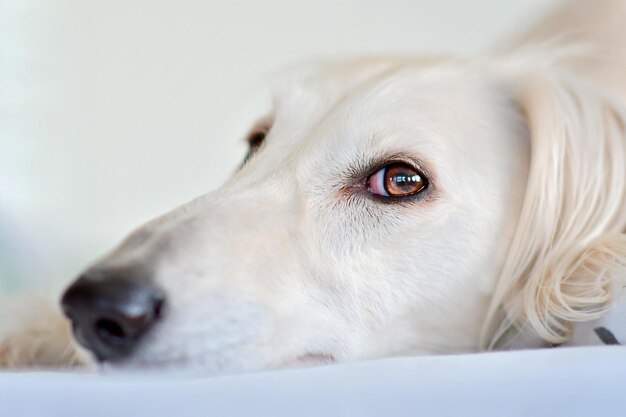Understanding Cataracts in Dogs: What Every Pet Owner Needs to Know
When it comes to ensuring the health and well-being of your furry friend, it's important to be aware of the potential health issues that may affect them. One such issue that can often go unnoticed until it progresses is cataracts. These are not just limited to humans; dogs can also experience this condition, which can significantly impact their quality of life. This guide will explore what cataracts are, their causes and symptoms, how they are diagnosed, and the potential treatments available for dogs suffering from this condition.
🐶 What Are Cataracts in Dogs?
Cataracts in dogs, much like in humans, involve the clouding of the eye's lens, leading to impaired vision that can range from mild to complete blindness. The lens is an essential part of the eye, responsible for focusing light and creating clear images. When the lens develops opacity, it interrupts this process, making it difficult for the dog to see.
Common Causes of Cataracts in Dogs
While cataracts can appear in any dog, certain factors increase their likelihood. Here are some common causes:
Genetic Predisposition: Some breeds are more prone to developing cataracts due to hereditary factors. Breeds like the Cocker Spaniel, Poodle, Siberian Husky, and Boston Terrier are notable examples.
Diabetes Mellitus: Canine diabetes can lead to the rapid development of cataracts. If your dog has diabetes, regular eye checks are crucial.
Age: As dogs age, their risk for developing cataracts increases simply due to the wear and tear on their eyes.
Injury or Trauma: Physical injuries to the eye can lead to cataract formation.
Environmental Factors: Prolonged exposure to radiation or harmful substances may also contribute to cataract development.
Recognizing Symptoms of Cataracts in Dogs
Early detection is key in managing cataracts, so being vigilant about the signs is vital. Here are symptoms to watch for in your dog:
Cloudy Eye Appearance: The most obvious sign is a visible cloudiness or opacity in one or both eyes.
Vision Impairment: Your dog may become hesitant to walk in unfamiliar areas, bump into furniture, or become less active.
Behavioral Changes: Increased anxiety or frustration, particularly in new environments or around obstacles.
Eye Irritation: Redness, squinting, or excessive blinking can indicate discomfort or vision issues.
🩺 Diagnosing Cataracts in Dogs
Monitoring your dog for the symptoms mentioned can help, but a professional diagnosis is essential. A veterinarian can often make a preliminary assessment of cataracts through a standard eye examination. More definitive diagnoses and planning for treatment may require further specialized tests by a veterinary ophthalmologist.
Steps in Veterinary Examination
Visual Acuity Test: Tests to assess the extent of your dog's vision loss.
Ophthalmic Examination: Using tools to examine the interior structures of the eye more closely.
Tonometry: A painless process to measure the pressure in the eye, essential for ruling out other conditions like glaucoma.
Blood Tests: Particularly important in diabetic dogs to better understand overall health and inform treatment.
🏥 Treatment Options for Dogs with Cataracts
While some dogs can adapt to partial vision loss, treating cataracts can improve their quality of life. Treatment primarily depends on the extent of cataracts and the dog's overall health.
Non-Surgical Management
In some cases, managing the underlying conditions that contribute to cataracts may slow their progression. This is particularly true for diabetic dogs, where controlling blood sugar levels is crucial.
Medications: While not curative, anti-inflammatory drops and other medications can help manage symptoms and prevent complications.
Nutritional Support: Supplements or diets rich in antioxidants may be recommended by veterinarians to support eye health.
Surgical Options
The most effective treatment for cataracts is surgical removal. This is typically recommended if the cataracts significantly impair the dog’s quality of life.
Phacoemulsification: This procedure involves using ultrasound waves to break up the cataract, which is then removed and replaced with an artificial lens.
Recovery and Care: Post-operative care is crucial for recovery, involving regular follow-ups, medications, and possibly the use of an Elizabethan collar to prevent the dog from damaging the eye.
🛡️ Preventive Measures and Next Steps
While cataracts are not always preventable, several strategies can reduce the risk or slow progression:
Regular Vet Check-Ups: Regular eye examinations can help catch the early signs of cataracts.
Balanced Diet: Ensuring your dog has a diet rich in antioxidants may promote better eye health.
Safe Environment: Preventing eye injuries through a safe home environment can reduce the risk of traumatic cataracts.
Monitoring: Keep a close eye on any changes in behavior or eye appearance and consult your vet promptly if you notice anything unusual.
📚 Quick Reference Guide
Here’s a succinct summary of key tips and insights about cataracts in dogs:
- 🧐 Observe Signs: Look for cloudiness, behavioral changes, and signs of vision impairment.
- 👩⚕️ Regular Check-Ups: Early detection through vet visits can manage cataract progression.
- 🍽️ Nutritional Support: Consider antioxidant-rich supplements for eye health.
- 🦺 Safety First: Minimize risks by providing a safe play and living environment.
- ⚕️ Know Your Options: Discuss both surgical and non-surgical treatment paths with your vet.
💡 Key Takeaway: While cataracts can impact your dog's life, with vigilant care, regular check-ups, and informed decisions, you can help maintain their eye health and quality of life.
Cataracts, though challenging, don't have to be debilitating. By understanding the signs and taking proactive steps, you can ensure your beloved pet continues to enjoy a joyful and active life. Always consult your veterinarian for a tailored approach to your pet’s needs and stay informed about developments in veterinary ophthalmology.
